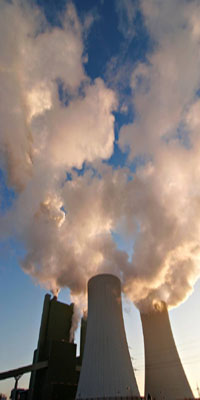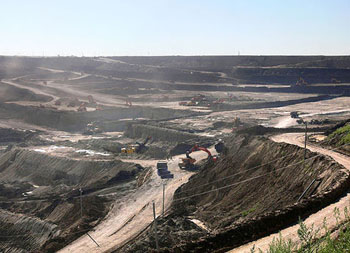

"Every time we use or consume energy we alter our environment. "

Cooling towers for a nuclear
power plant.
Environmental Considerations
Making Better Choices about our Energy Sources
How Energy Impacts our Environment
Every time we use energy, we impact the environment.

It’s been said there is no such thing as clean energy, which is not far from the truth. If we burn any number of different fuels, we produce pollutants and lots of CO2. Solar PV panels – a shining (sorry) example of “green energy” – rely on a manufacturing process that consumes considerable amounts of energy and throws off toxic silicon tetrachloride waste. Wind and water, both excellent renewable energy sources, carry their own environmental footprints. We won’t even go into fossil fuels and nuclear power.
Face it: every time we use solar, wind, water, nuclear, coal or any other energy resource, we alter our environment.

When you think about it, the simple act of eating an energy-packed apple interrupts the natural return of nutrients to the earth and forces us to produce, shall we say, toxic waste. So we find ourselves in a bit a quandary. We must consume energy. At the very least, we must feed our bodies, keep warm, and get from place to place. Then come the non-essentials, where even the most environmentally conscious of us consume energy for things we don’t absolutely need – such as reading this web page.
Okay, but we still want to protect our environment. What do we do?
Minimizing our Footprint

Since we cannot escape impacting the environment with our energy use, our challenge is to minimize the damage. An electric car, for example, produces fewer emissions than its gasoline cousin, even when you consider the fuel used to generate the electricity. But in defense of the gasoline car, its emissions are probably less objectionable than the horse it replaced (especially when you put a few thousand on downtown streets).
Everything affects our environment, but some things are worse than others.
Making Informed Choices

In addition to the CO2 and mercury emissions from coal-fired generating plants, the coal mining process dramatically alters vast stretches of landscape and often fills low-lying watersheds with contaminants. Usage of fossil fuels and CO2 emissions also occur when coal is transported from the mine to the generating plant.
In addition to the CO2 and mercury emissions from coal-fired generating plants, the coal mining process dramatically alters vast stretches of landscape and often fills low-lying watersheds with contaminants. Usage of fossil fuels and CO2 emissions also occur when coal is transported from the mine to the generating plant.
Prudent decisions about energy require intelligent evaluation of our alternatives. As we examine fossil fuels, water, wind, solar and nuclear energy sources, we should not focus solely on whether there will be negative impact (there will be), but instead understand which options cause the least environmental damage. While we’re at it, we might also want to consider our dependency on foreign nations.

Continue to Comparing Energy Sources
